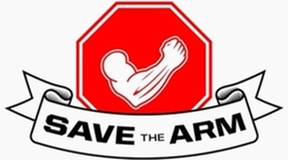Despite all the awareness that Save The Arm brings to the issue of reducing injuries to those with a condition where an arm should not be exposed to IV, PICC Line, injections, venapuncture and/or pressure and trauma, it is essential that for injury to be reduced that the concept be integrated as part of standard operating procedures. The following examples are where Save The Arm methodology and protective products might be used to reduce injury to patients.
Clinic, Emergency Room or Hospital Front Desk:
1. Always ask the patient and check the patients record to assure that they do not have an arm or condition which should be excluded from receiving IV’s, PICC Line’s, injections,venapuncture and/or pressure and trauma. Also assess if the patient has had previous negative experience with receiving therapy in an arm on which they would not like to receive therapy in the future.
2. If a patent is identified as having a protected condition or needs to have Arm Protection, by protocol that person should be identified in writing in the chart and also by a visible method such as a Save the Arm Alert Safety Sleeve or applied Save the Arm Alert Safety Tape. This should be applied by staff if at all possible and the patient should be educated as to the reason it is being applied and encouraged to ask for this material if they return to the facility.
Phlebotomy:
1. Use the 5 A’s and Ease on every patient, every time prior to any intervention.
2. If a patent is identified as having a protected condition or needs to have Arm Protection, by protocol that person should be identified in writing in the chart and also by a visible method such as a Save the Arm Alert Safety Sleeve or applied Save the Arm Alert Safety Tape. This should be applied by staff at the point it is discovered if at all possible and the patient should be educated as to the reason it is being applied and encouraged to ask for this material if they return to the facility.
3. Track number of misses and near misses regardless of whether actual injury occurred over time and treat each event as an opportunity to learn and improve.
Hospital Inpatient and Outpatient Departments:
1. Each and every staff follows the 5 A’s on every patient every time and use the EASE technique to reduce events which can harm the arm.
2. If a patent is identified as having a protected condition or needs to have Arm Protection, by protocol that person should be identified in writing in the chart and also by a visible method such as a Save the Arm Alert Safety Sleeve or applied Save the Arm Alert Safety Tape. This should be applied by staff at the point it is discovered if at all possible and the patient should be educated as to the reason it is being applied and encouraged to ask for this material if they return to the facility.
3. Track number of misses and near misses regardless of whether actual injury occurred over time and treat each event as an opportunity to learn and improve.
Physicians, Nurses Medical Technicians and Phlebotomists:
1. Educate every patient with a protected arm how to take care of their arm and help prevent injury.
2. Educate staff to always ask the patient and check the patients record to assure that they do not have an arm or condition which should be excluded from receiving IV’s, PICC Line’s, injections,venapuncture and/or pressure and trauma. Also assess if the patient has had previous negative experience with receiving therapy in an arm on which they would not like to receive therapy in the future.
3. If a patent is identified as having a protected condition or needs to have Arm Protection, by protocol that person should be identified in writing in the chart and also by a visible method such as a Save the Arm Alert Safety Sleeve or applied Save the Arm Alert Safety Tape. This should be applied by staff if at all possible and the patient should be educated as to the reason it is being applied and encouraged to ask for this material if they return to the facility.
4. Assure your hospital or medical facility supports a protocol that assures that Save The Arm methodology and visible alert devices and educational material are prominently displayed and used in protocols. Save the Arm Alert Safety Sleeve’s or applied Save the Arm Alert Safety Tape should be available and ready to hand out to all patients who need it. Patients with a chronic condition requiring or potentially requiring arm protection should be given supplies for home and out of facility use.



